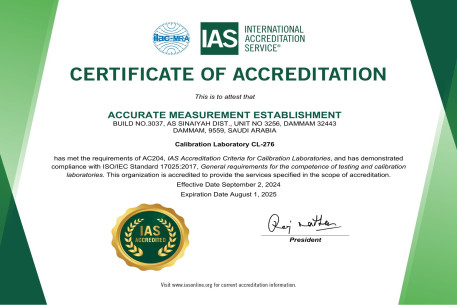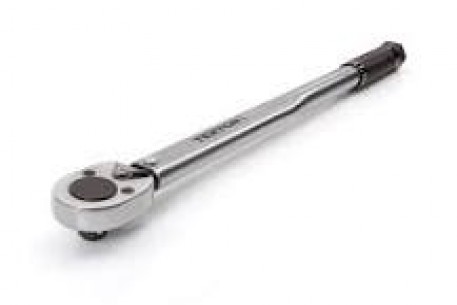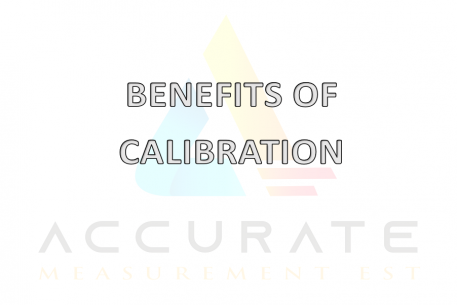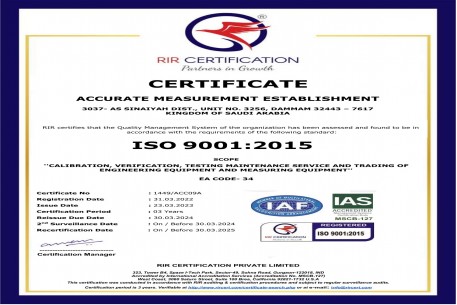BLOG
Accreditation Certificate
Accreditation Certificate Effective Date September 2, 2024 Expiration Date August 1, 2025

Torque Wrench
What is a Torque Wrench? A torque wrench is a tool used to apply a specific torque to a fastener such as a nut, bolt, or lag screw. Torque is a measure of how much force acting on an object causes that object to rotate. A torque wrench is a precision tool that guarantees reliable and quality tightening. Its use is essential to avoid any deterioration or breakage on the various clamping parts in the industry. It is commonly used in various fields such as engineering, manufacturing, Oil & Gas Industries, and automobile industries. Torque wrenches Classification: Based on International Standards(ISO 6789-1: 2017) torque wrenches are classified as follows Indicating Torque Tools(Type-I): Tools that indicate by means of a mechanical scale, dial or electronic display, the value of torque exerted by the tool at the output drive. )1. Class A: Wrench, torsion or flexion bar;2. Class B: Wrench rigid housing, with scale or dial or display;3. Class C: Wrench rigid housing and electronic measurement;4. Class D: Screwdriver, with scale or dial or display;5. Class E: Screwdriver with electronic measurement; Setting Torque Tools(Type-II): Tool sensing torque transmitted by comparing the torque applied with a self-contained standard and signaling the transmission of the pre-selected value by a physical impulse, with or without audible signal, causing a temporary reduction in the torque applied.1. Class A: Wrench, adjustable, graduated or with display;2. Class B: Wrench, fixed adjustment;3. Class C: Wrench, adjustable, non-graduated;4. Class D: Screwdriver, adjustable, graduated, or with display;5. Class E: screwdriver, fixed adjustment;6. Class F: Screwdriver, adjustable, no-graduated;7. Class G: Wrench, flexion bar, adjustable, graduated. Calibration and permissible deviation: If the user does not utilize a control procedure, the duration period of calibration is 12 months or 5000 cycles, whichever occurs first is considered for recalibration of the torque wrench. Permissible deviation is based on class and the type of torque wrench is given below. Maximum permissible relative deviation (Type II) Class Maximum torque value ≤10 N.m ≥10N.m ± 6 % ± 4% ± 6 %

Vernier Caliper
The vernier caliper is a measuring instrument used to accurately measure small distances with a high degree of precision. It consists of an inner and outer set of jaws, one of which is fixed while the other can be moved using a sliding mechanism. The jaws are used to grip the object being measured, and a scale is attached to the caliper body to indicate the measurement. The vernier scale provides additional accuracy by allowing users to read measurements between the graduations on the main scale. This mechanism makes the vernier caliper well-suited for measuring dimensions such as the internal and external diameter of objects, depth, and thickness. It is commonly used in various fields such as engineering, manufacturing, and scientific research. The vernier caliper offers a reliable and efficient way to obtain precise measurements, helping to ensure accurate results in various applications. Maximum Permissible error of Vernier Caliper Maximum permissible error (MPE) values apply to any indication permitted for use of calliper as defined by the manufacturer and when used in accordance with the manufacturer's recommendation .The MPE Values cannot be smaller than the digital step or the scale interval on the circular scale or vernier scale There are mainly three Error are consider in the calliper 1. Partial Surface contact error , E (limited by EMPE) 2. Shift Error ,S (limited by SMPE) 3. Line Contact Error The Maximum Permissible Error of Line Contact Error (Paralleslism) The Line contact is calculated as the range of the measured values. The MPE value for line contact error is equal to the range of EMPE. That is if EMPE = ± a Then the MPE for line contact error is 2a Example : The maximum permissible error of Partial Surface contact error (EMPE) of 150 mm Digital Calliper is ±20 µm, The Maximum Permissible error of line contact error is 2*20 That is 40 µm

Perfect Method of Weighing
. Analogue Weighing Methods A. Traditional Balances: Traditional balance scales operate on the principle of comparing two masses. By utilizing the principles of moment and equilibrium, these scales provide an accurate measurement of weight. Although they offer simplicity and reliability, they can be influenced by factors like temperature and air density. B. Lever Systems: Lever systems, including single-pan scales and equal-arm balances, leverage the mechanical advantage of levers to determine weight. Different types of lever systems, such as steelyards and torsion balances, find applications in diverse industries due to their ability to provide consistent measurements. C. Spring Scales: Spring scales employ the spring's deflection to measure weight. These scales are widely used due to their portability and ease of use. Analyzing their accuracy and appropriateness for specific applications is crucial, as their performance can be affected by factors such as spring fatigue and temperature variations. V. Digital Weighing Methods A. Load Cells: Load cells are transducers that convert force into an electrical signal. They form a vital component of digital weighing systems, providing high accuracy and precision. Different types of load cells, such as strain gauge and hydraulic load cells, cater to various usage scenarios, ensuring reliable measurements. B. Electromagnetic Force Restoration (EFR) Weighing: EFR weighing technology utilizes electromagnetic forces to counterbalance the weight being measured. Offering benefits like high resolution and fast response time, EFR weighing is an effective digital method. However, its limitations include susceptibility to electromagnetic interference. C. Piezoelectric Weighing: Piezoelectric weighing relies on the principle of piezoelectricity, where certain crystals generate an electric charge when subjected to mechanical stress. This method finds applications in dynamic weighing due to its fast response and accuracy. Comparing it to other digital weighing methods helps determine its suitability for specific applications. D. Strain Gauge Load Cells: Strain gauge load cells measure the strain applied to them when subjected to a load. They provide excellent precision and are widely used in industrial applications. Evaluating their accuracy and maintenance requirements ensures optimal performance and longevity.

Benefits of Calibration
1.Introduction: Understanding the Concept of Calibration Calibration is the process of adjusting and comparing measurements to ensure accuracy and precision. It involves comparing the readings of a device or instrument to a known standard, enabling the correction of any deviations. By calibrating instruments, industries can obtain accurate and reliable measurements, crucial for their operations. 2.Importance of Calibration in Various Industries: Calibration plays a vital role across a wide range of industries. From healthcare and manufacturing to aerospace and automotive, calibration ensures the accuracy of measurements, enhances productivity, and guarantees compliance with quality standards. It is a crucial aspect of maintaining efficiency and reliability in various sectors. 3.The Science Behind Calibration: 3a. Definition and Significance of Calibration: Calibration is the systematic process of checking, adjusting, and documenting the performance of instruments or devices against traceable standards. It ensures measurements are accurate, valid, and reliable. Without calibration, measurements may produce erroneous results, leading to detrimental consequences in terms of cost, safety, and quality. 3b: Introduction to Calibrated Instruments and Devices: Calibrated instruments and devices are those that have been adjusted and verified for accuracy. They have undergone a meticulous process where their measurements are compared to traceable standards, resulting in calibration certificates. These instruments are essential for acquiring precise measurements in industries that demand accuracy and consistency. 4.Ensuring Accuracy: Why Calibration Matters: 4a. Enhancing Measurement Precision: Calibration goes beyond merely verifying the instruments' accuracy; it also enhances their precision. By eliminating measurement errors and deviations, calibration enables industries to obtain precise data crucial for decision-making, quality control, and research purposes. It ensures that measurements are as close as possible to the true value. 4b. Maintaining Consistency and Reliability: Consistency and reliability are vital factors in any industry. Calibration ensures that measurements remain consistent over time, regardless of external factors or the equipment's age. This consistency enhances reliability and trust in the data obtained, leading to more informed decision-making and improved processes. 4c. Compliance with Quality Standards: Various industries are subject to stringent quality standards and regulations. Calibration is a requirement to meet these standards, ensuring that measurements and processes align with industry-specific guidelines. It provides evidence of compliance during audits and certifications, demonstrating a commitment to maintaining high-quality operations. 5. Streamlining Operations through Calibration: 5a. Improving Efficiency and Productivity: Calibration plays a crucial role in streamlining operations by improving efficiency and productivity. When instruments are accurately calibrated, time spent troubleshooting or recalibrating faulty equipment is reduced. This leads to increased productivity as employees can confidently and efficiently work with calibrated instruments. 5b. Reducing Downtime and Production Costs: Calibration helps reduce downtime and production costs by identifying potential issues before they escalate. Regular calibration prevents unexpected breakdowns or errors, allowing for timely maintenance or repairs. By minimizing interruptions in the production process, businesses can save on costly downtime and improve overall operational efficiency. 6. Calibration in Healthcare and Laboratory Settings: 6a. Precision in Diagnosis and Treatment: In healthcare and laboratory settings, calibration is critical to ensure precision in diagnosing illnesses and administering treatment. Calibrated instruments, such as medical devices and laboratory equipment, enable accurate measurements of patient vital signs, blood samples, and drug concentrations. Precise measurements contribute to accurate diagnoses and appropriate treatment plans. 6b. Ensuring Validity of Test Results: Laboratory testing relies heavily on calibrated instruments to ensure the validity of test results. From blood and tissue analysis to environmental and pharmaceutical testing, accurate measurements are essential for reliable findings. Calibration guarantees that the instruments used produce results within an acceptable range, fostering confidence and trust in test outcomes.

Accrditation Certificate
ISO 17025: 2017 Accreditation Certificate of Accurate Measurement Est

ISO 9001:2015

WORLD METROLOGY DAY
WORLD METROLOGY DAY- 20 MAY 2023


